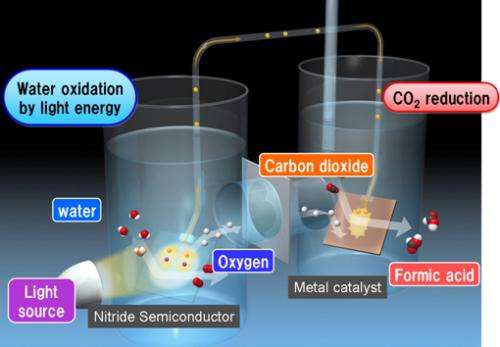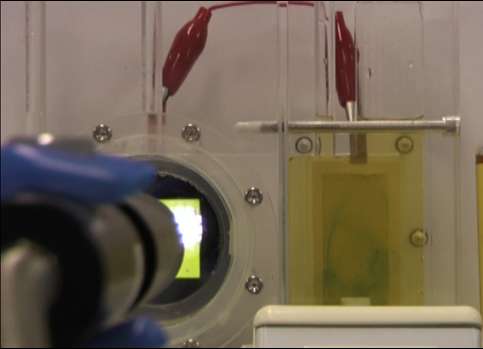Panasonic develops efficient artificial photosynthesis system generating organic materials from carbon dioxide, water

Panasonic has developed an artificial photosynthesis system which converts carbon dioxide (CO2) to organic materials by illuminating with sunlight at a world's top efficiency of 0.2%. The efficiency is on a comparable level with real plants used for biomass energy. The key to the system is the application of a nitride semiconductor which makes the system simple and efficient. This development will be a foundation for the realization of a system for capturing and converting wasted carbon dioxide from incinerators, power plants or industrial activities.
CO2 is one of the substances responsible for greenhouse effect and as such, efforts are being made to reduce the emissions of CO2 worldwide. The problem of CO2 is also directly connected to an issue of the depletion of fossil fuels. Artificial photosynthesis is the direct conversion from CO2 into organic materials, which can solve both of these problems.
In the previous approaches so far, the systems have had complex structures such as organic complexes or plural photo-electrodes, which makes it difficult to improve their efficiency in response to the light. Panasonic's artificial photosysnthesis system has a simple structure with highly efficient CO2 conversion, which can utilize direct sunlight or focused light.

We found firstly that a nitride semiconductor has the capability to excite the electrons with enough high energy for the CO2 reduction reaction. Nitride semiconductors have attracted attention for their potential applications in highly efficient optical and power devices for energy saving. However, its potential was revealed to extend beyond solid devices; more specifically, it can be used as a photo-electrode for CO2 reduction. Making a deviced structure through the thin film process for semiconductors, the performance as a photo-electrode has highly improved.
The CO2 reduction takes place on a metal catalyst at the opposite side of nitride semiconductor photo-electrode.(See Fig. 1) The metal catalyst plays an important role in selecting and accelerating the reaction. Here, it is noted that the system comprises of only inorganic materials, which can reduce the CO2 with low energy loss. Because of this, the amount of reaction products is exactly proportional to the light power. This is one of the merits in such an all-inorganic system while some conventional systems cannot follow the light power in general because of their internal or external rate-limiting processes in the complex structures.
The system with a nitride semiconductor and a metal catalyst generates mainly formic acid from CO2 and water with light at a world's top efficiency of 0.2%. The efficiency is of a comparable level to real plants used in the biomass energy source. The formic acid is an important chemical in industry for dye and fragrances. The reaction rate is completely proportional to the light power due to the low energy loss with simple structure; in other words, the system can respond to focused light. This will make it possible to realize a simple and compact system for capturing and converting wasted carbon dioxide from incinerators and electric generation plants.
On this development, Panasonic holds 18 domestic patents and 11 overseas patents, including pending applications.
This development was partially presented at 19th International Conference on the Conversion and Storage of Solar Energy held on Pasadena, United States on July 30, 2012.
Provided by Panasonic





















